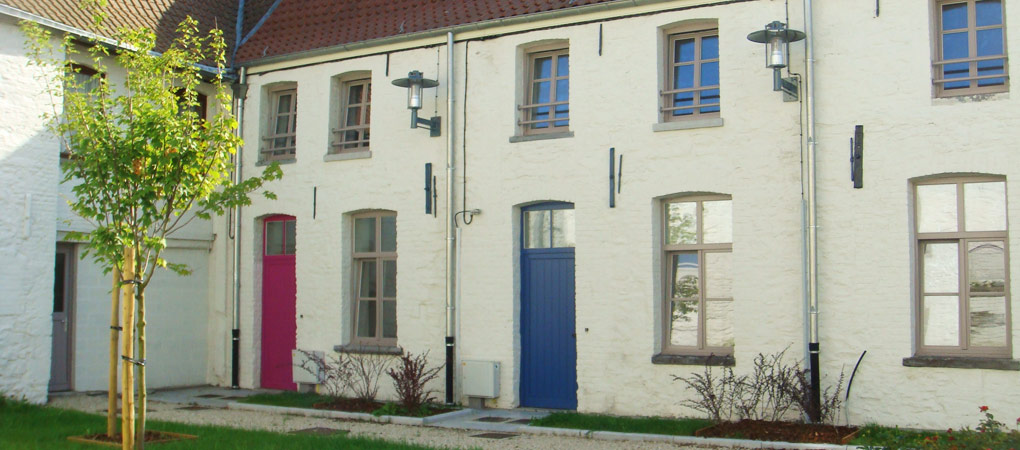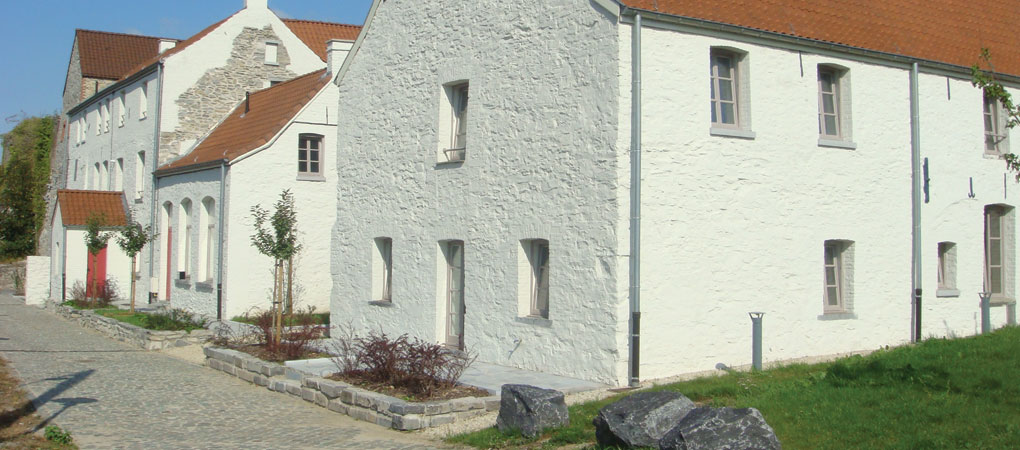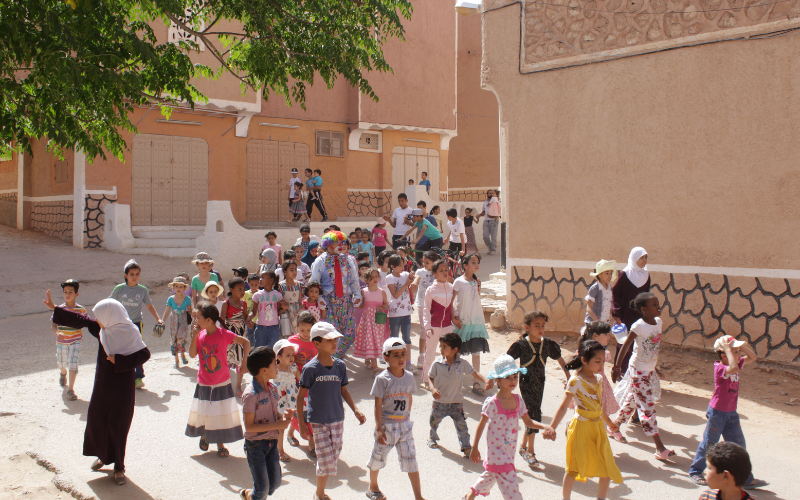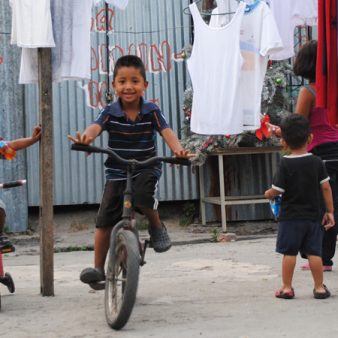In response to a public campaign launched in 2002, Le Logis Tournaisien, a regionally–based public sector housing company operating in the Walloon region of Belgium, embarked upon the refurbishment of a group of severely dilapidated ex quarry workers’ houses in the hamlet of Allain. The exercise served both to increase the social housing stock and to restore local pride in the area. Eleven housing units were restored, where previously only five had been inhabitable. The restoration was carried out preserving much of the original design and is celebrated as an example of a local community coming together to restore pride in the local heritage.
Project Description
Aims and Objectives
- To respond to local calls to preserve and renovate the ex-quarry workers’ dwellings.
- To provide additional good quality social housing units.
- To restore pride in the area among residents.
Context
As social, and in particular family, structures have changed in Belgium, more and more young people are in need of affordable housing. An ageing population has also increased demand for housing, particularly from older people preferring to stay in town centres, within easy reach of the local shops and services. Small households with one or two persons are increasingly the norm and people often make greater use of the house with higher levels of unemployment and longer retirement periods. An increasing tendency has been for housing designated for those on low incomes to be spatially separated from housing for wealthier individuals, leading to problems associated with residualisation and ghettoisation.
The houses built in the hamlet of Allain, on the river Scheldt near Tournai, although constructed 150 years ago by the local limestone quarry workers, had the potential to meet these emerging needs. However, by 2002, the workers’ dwellings had fallen into disrepair and were destined for demolition as part of a development plan put forward by the Town Council to allow private investors to develop a commercial centre and car park on the site.
Key features
After months of public campaigning and with good media support, the inhabitants of Allain secured a pledge from the Tournai Town Council to make subsidies available for the purchase and refurbishment of a group of severely dilapidated ex quarry workers’ houses. Money was secured for the project from funding sources dedicated to improving the safety and upkeep of public buildings and to preserving the local heritage. Le Logis Tournaisien acquired full rights over the ex quarry workers’ properties, signing a long lease with the Town Council and set about preserving this important part of the town’s heritage, whilst also responding to a growing demand for social housing in the area.
A total of 11 dwellings were created from the renovations – two with three bedrooms, four with two bedrooms and five with one bedroom, to meet the demands of a society in which family patterns are changing. Plans were made with the pending Heritage Listing and Heritage Certificate requirements in mind. The houses retain some of the water- and energy-saving features installed by their original builders, including small windows (so that houses are cool in summer and better protected in winter), the collection of water from the roofs into cisterns, the grouping together of the houses and their multiple stories for effective use of space. Since they face to the South and away from the hill and lime kilns, the houses capture the sun’s rays all year round and escape prevailing winds. In addition, the proximity of the houses and communal feel to the complex of buildings fosters a sense of community among residents.
The drainage of the site was improved during the works and the newly refurbished quarry workers’ houses are now the starting point of the local tourist excursion, the ‘Stone Circuit’. A Conservation Committee has been set up to work to preserve the heritage of the Allain hamlet, and further enhance the Tournai quarry basin area.
Covering costs
The total cost of renovating the dwellings was US$2,489,839, putting the average cost of renovation per unit at US$226,349. Seventy-five per cent of the funding came from public grants and subsidies, with 25 per cent coming from Le Logis Tournaisien’s own funds. The relatively high costs are explained by the specialist nature of the reconstruction work.

Impact
- The residents of the ex-quarry workers’ houses benefit from significantly improved living conditions and have an increased sense of pride in their homes and the broader site.
- The ex-quarry mining area has attracted significant attention since the renovation work was carried out (e.g. the Heritage Listing and Heritage Certificate candidature).
- The provision of high quality accommodation in the social housing sector has helped to generate a better understanding that social housing and its residents are not always associated with vandalism, crime and verbal violence.
Why is it innovative?
- The renovation was as a result of the local community mobilising around the cause of restoring this historic part of the town that was due for demolition.
- The original features of the houses have been preserved, including original oak beams, chimneys and even the stone trough from the stables. The communal area was also restored to promote the kind of community living practised by the original quarry worker inhabitants.
- The houses provide residents with a sense of pride in their homes and their local heritage.
- These highly attractive properties have been allocated to those with the most pressing housing needs (i.e. at the top of the local social housing waiting list). Although re-sale of the housing units is highly unlikely due to their collective nature, mechanisms are in place to prevent gentrification, should authorisation be granted by the Région Wallone (regional authority) for Le Logis Tournaisien to sell. Only the inhabitants of the houses at the time would have the right to buy the units and on the condition of no re-sale within a ten year period (unless sold back to Le Logis Tournaisien at the purchase price).
What is the environmental impact?
- Existing buildings have been re-used rather then demolished, thus avoiding the need to use new building materials.
- The original buildings were constructed from the locally available limestone and timber from the nearby forests and thus had very low embodied energy at point of construction.
- Energy-efficient initiatives developed by the quarry workers 150 years ago such as the collection of water from the roofs into cisterns and the South-facing positioning of the houses, sheltering them from the winds, have been retained.
- The new social housing units are located within easy reach of shops and services, reducing travel distances.
- The homes are within easy walking distance of the town, thus reducing driving to work and parking pressures.
- The regional housing authority has selected Allain as the site for a new environmentally sustainable social housing project providing 18 dwelling units and a crèche, all built at an affordable cost and designed to deliver environmental, social and financial sustainability. The decision was due in part to the positive work already carried out with this project in the hamlet.
Is it financially sustainable?
- The project was funded by grants and loans from public bodies. Ongoing repairs and maintenance are paid for by Le Logis Tournaisien, which has a secure income from the rent on the properties it lets in the region.
- Residents live in better condition, for example with exclusive toilet facilities for each household, improved heating and security provision, and so are in a better position to improve their income-generating capacity.
- The provision of 11 affordable housing units in the hamlet enables local people to stay in the area, rather than move to nearby towns.
- The highly unlikely prospect of the units being sold means that the community will benefit from the additional social housing units for a substantial period of time.
What is the social impact?
- Residents and community members feel a joint sense of ownership over the site and a renewed sense of pride in their heritage.
- The communal nature of the site, with its central courtyard and enclosed design, encourages interaction between residents as they go about their daily lives.
- The resident movement demanding the renovation called upon the teamwork, lobbying and communications skills of local community members.
- Residents live in better conditions, for example not having to share toilets, and in warm accommodation that is affordable to heat.
- The new residents were taken from the social housing waiting list and so people in need have been better housed as a result of the project.
- Guarantees are also in place to ensure that the housing units will continue to benefit those in need in the community.
- The project has seen a community movement to protect the old quarry workers’ houses succeed, both in terms of securing funding for the renovation and following the project through to its end.
- A Conservation Committee has been established in the hamlet to further enhance and preserve the local heritage and environment.
Barriers
Renovation plans had to be made to comply with rules that would apply if the site were to be granted a heritage listing (no final decision has been made on this yet).
Obtaining planning permission to renovate the properties was a lengthy procedure and delays with ensuring that those tenants who needed more supportive housing and care had appropriate accommodation to go to.
Lessons Learned
The original features of older properties can be preserved to achieve energy efficiency, a renewed sense of community and common ownership of a town’s heritage, as well as increasing the stock of social housing available for vulnerable people.
Evaluation
After two years of occupation, an audit on the housing will be carried out comprising: an assessment of the degree of satisfaction of the occupants (comfort, functionality, living costs etc), an analysis of the consumables borne by the tenants, quantification of losses, the energy efficiency of the buildings and the total cost price.
Transfer
There has been no scaling up of the project. It is celebrated as an example of a local community coming together to restore pride in the local heritage.
The renovation of the quarry workers’ houses in the hamlet of Allain into social housing sparked an interest in sustainable housing development. The Walloon Housing Associations umbrella body and funder (SWL) has given permission and funding to Le Logis Tournaisien for the development of 18 dwelling units and a nursery on the old football pitch in the hamlet. This project is to be financed in part by the European Union.
Partnership
National government, CBO, Private sector



